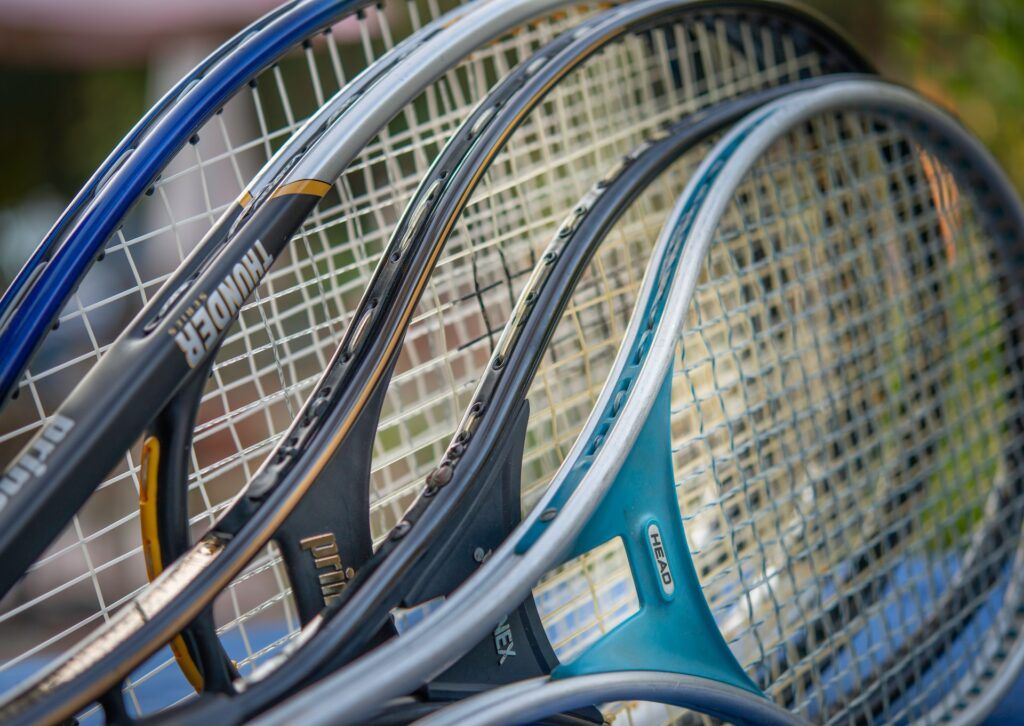6 Tennis Bag Essentials for Every Player

Tennis doesn’t require a lot of equipment but there are certain items you absolutely can’t do without.
Tennis has a slew of physical, social, and mental health benefits, so it’s not a surprise that it’s one of the most popular sports in the world, played by 87 million people globally every year. Tennis doesn’t require a lot of equipment, but there are some tennis bag essentials you absolutely can’t do without.
Among its benefits for adults and seniors, tennis can strengthen your bones, reduce your stress levels, help you lose weight, improve your cardiovascular fitness, and even assist you in building new relationships within communities, according to the United States Tennis Association.
If you’re new to tennis and want to experience all of these health benefits for yourself, you may be wondering what are some of the essentials you need to bring to the court with you.
So, here’s a list of 6 essential items for every tennis bag.
Tennis Rackets

Well, this one’s obvious. But notice that we say “rackets,” not just one racket. Professional players will usually carry at least 5 extra rackets in their bag, but if you’re playing recreationally, one extra racket (which should ideally be the same as your main one) should suffice – so that in the event a string breaks, you don’t have to stop playing.
Choosing the right racket for you will depend on your game style, the surface you are playing on, and your experience level. String tension on your racket is particularly important to help reduce the shock on your elbow.
In addition, choosing the grip size that fits you perfectly is imperative to prevent the likelihood of injury to your wrist and elbow. If you’re unsure what is the ideal racket for you, we recommend consulting a professional to help you determine the type of racket that will improve your game and reduce your chances of injury.
Discover an injury prevention device
Tennis Balls
Just like with rackets, bringing some extra tennis balls with you on the court is necessary. We recommend one or two cans of three balls each. The type of balls depends on the court surface, as well as your age and level of experience.
Make sure not to use old tennis balls as they tend to get worn out and can lead to injuries such as tennis elbow (also known as lateral epicondylitis, a condition that causes pain around the outside of the elbow). Fresh tennis balls will feature better sensation, reactivity and bounce, making playing easier.
Note that in professional matches, tennis balls are changed every 7-9 games. Now, this is not to say recreational players should do the same, but you should keep in mind that tennis balls do get worn out fairly quickly and should be regularly replaced.
Water Bottle
After the racket and the balls, a reusable water bottle will be the most important item in your tennis bag. Regardless of the temperatures and conditions you are playing in (and whether you are indoors or outdoors), a bottle of water or electrolyte drink is absolutely critical to help keep you fresh and hydrated, and to prevent you from passing out on the court.
You can choose from many types of water bottles, but ideally you should pick one that can stay cool for hours. Alternatively, if you are playing in sweltering conditions, you may also bring a cooler to keep your liquids cold. Even though it generally depends on the needs of each individual, you should have at least 24 oz (around 700 ml) of water or electrolyte drink in your tennis bag.
Towels

Tennis is quite a physically demanding sport, so you’re likely to sweat a lot, especially if you’re playing in the heat. But make no mistake, sweating from a physical activity like tennis has many health benefits, including boosting endorphins, releasing toxins from the body, lowering kidney stone risk, and preventing germs and other pathogens.
Put at least a couple of towels in your tennis bag, preferably cotton, to help you absorb sweat better. Pay particular attention to keeping your hands dry to prevent your racket from moving around or slipping off your hand and causing blisters. An extra shirt can also prove useful if you tend to sweat more.
Sun Protection
UV rays can be hazardous and cause sunburns, wrinkles, premature aging, liver spots and even skin cancer. Even if it’s mostly cloudy while on the court, do not underestimate the potential harm the sun can inflict on your skin.
Always, and we do mean always, wear sunscreen – dermatologists usually recommend SPF 30, which blocks around 97% of the sun’s UVB rays. You should also include a hat or visor, headbands, wristbands, as well as some lip balm in your tennis bag in case your lips dry out.
Near-Infrared and Red Light Therapy Device
Including a portable, ergonomic, and easy-to-use near-infrared and red light therapy device such as the FlexBeam in your tennis bag can help you better prepare before playing and recover after playing.

Discover an injury prevention device
Near-infrared and red light can help increase your muscle performance, accelerate the healing of your wounds, boost your energy levels, manage your pain, decrease inflammation, and improve fatigue and muscle recovery.
There’s no end to the benefits that near-infrared and red light can provide, so including a therapy device in your tennis bag could not only help you improve your game but also prevent you from getting injuries that could leave lasting damage.
These are only the essential things you need in your tennis bag, but you could always add more things that could come in handy, such as extra clothes, backup strings, a first aid kit, and snacks (particularly granola bars, fruits, and vegetables, and lean proteins).
And yes, we know all of these things may make your tennis bag quite heavy, but having these items with you will ensure that you feel secure and fully prepared so that you can focus 100% of your energy and attention on enjoying yourself on the court.
Source:
- https://tennisracketball.com/guide/how-many-people-play-tennis/
- https://www.usta.com/en/home/improve/tennis-health—fitness/national/benefits-of-playing-tennis.html
- https://www.nytimes.com/2022/07/21/well/how-much-spf-is-enough.html https://pubmed.ncbi.nlm.nih.gov/21086010/
- https://www.liebertpub.com/doi/abs/10.1089/pho.2006.24.121
- https://www.jstage.jst.go.jp/article/islsm/14/0_Pilot_Issue_2/14_0_Pilot_Issue_2_0_45/_pdf https://onlinelibrary.wiley.com/doi/10.1002/jbio.201600176
